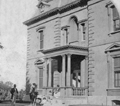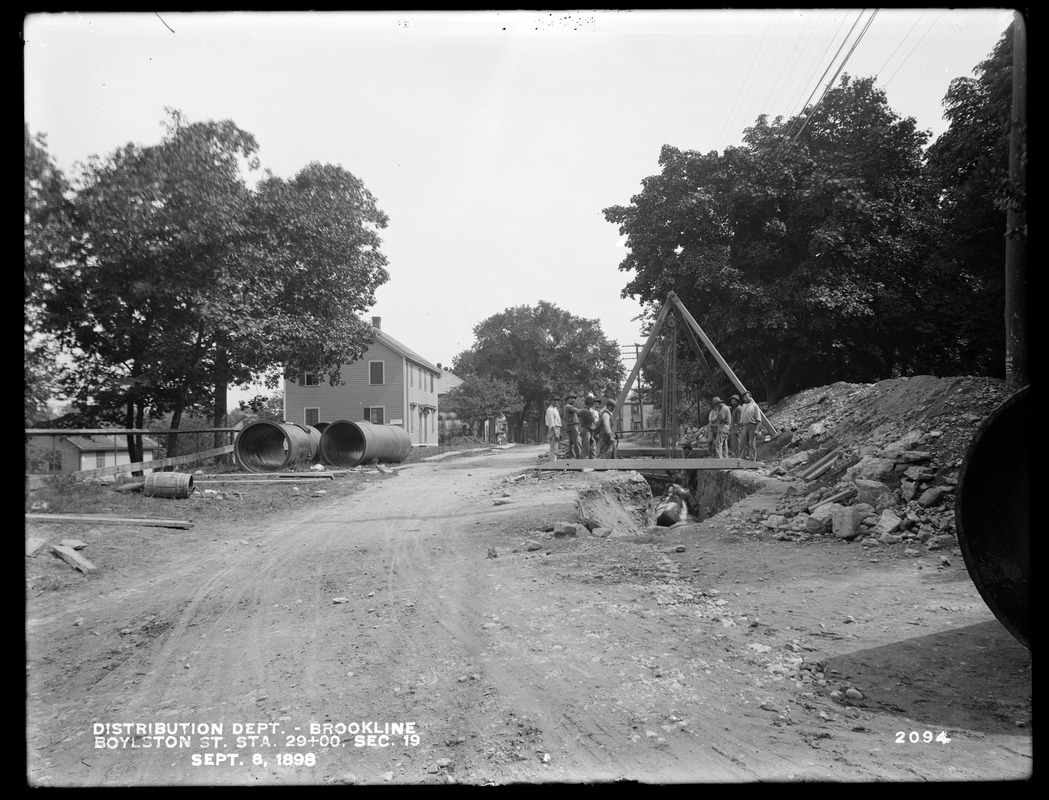 |
House of George Bacon. Later, Lowell House "Sevenels". 70 Heath St.
From a stereoview circa 1860-1865. Later purchased after the Civil War by Augustus Lowell and named "Sevenels" (Seven Lowells). Extensive exterior renovations in 1947.
Photography studio of Black and Batchelder, 172 Washington St. Boston.
|
 |
House of Edward Atkinson, Heath Hill
[Source: Brookline Preservation Department]
|
 |
House of Edward Atkinson, Heath Hill
[Source: Digital Commonwealth]
|
 |
Benjamin White House, 203 Heath St.
|
 |
Helen Dane Estate, 360 Heath St.
Now part of Pine Manor College
|
 |
Boylston Street, September 8, 1898
Looking east from Reservoir Lane. The duplex at 811/813 is on the left and still stands today.
[Source: Digital Commonwealth]
|
 |
Boylston Street, September 8, 1898
Looking west. Standing across from #811/813 just before the entrance to Reservoir Lane, barely visible on the right.
[Source: Digital Commonwealth]
|
 |
Boylston St. Between Eliot Rd. and Reservoir Rd.
Looking west toward Reservoir Rd. The two houses in the foreground right, #781 and #783 Boylston St. are still standing. In the distance on the left is the brick engine house that was later replaced by the current fire station across the street.
[Source: Brookline Preservation Department]
|
 |
Richard's Tavern, Heath St. near Hammond St.
Northeast corner of Heath and Hammond. Known as the "Old Stage Coach Tavern". Built circa 1760-70. The Worcester Turnpike (Rt. 9) passed behind the house where a tollgate was located.
|
 |
Richard's Tavern, Heath St. near Hammond St.
Northeast corner of Heath and Hammond. Known as the "Old Stage Coach Tavern". Built circa 1760-70. The Worcester Turnpike (Rt. 9) passed behind the house where a tollgate was located.
[Source: Digital Commonwealth]
|
 |
Richard's Tavern, Heath St. near Hammond St.
Northeast corner of Heath and Hammond. Known as the "Old Stage Coach Tavern". Built circa 1760-70. The Worcester Turnpike (Rt. 9) passed behind the house where a tollgate was located.
[Source: Digital Commonwealth]
|
 |
Boylston St. at Hammond St., 1922
Looking east from Hammond St. From right to center:
- Sing Lee, Laundry, 1174 Boylston St. (partial view)
- Apartment building, 1172 Boylston St.
- Apartment building, 1168 Boylston St.
- Large apartment building, 1164 Boylston St., still standing
[Source: Digital Commonwealth]
|
 |
Clubhouse, Chestnut Hill Country Club
Addressed as number 1023 on Boylston St. which runs right behind the clubhouse.
[Source: Brookline Preservation Department]
|
 |
Clubhouse, Chestnut Hill Country Club
Addressed as number 1023 on Boylston St. which runs right behind the clubhouse.
[Source: Brookline Preservation Department]
|
 |
1109 Boylston St.
[Source: Brookline Preservation Department]
|
 |
Boylston St., circa 1900
Looking east, Reservoir Lane. is unseen around the corner. This photo is likely made of the just-completed widening of Boylston St. and the laying of trolley tracks in late 1900. Note that the supporting poles of the electric feed stop abruptly on the north side where the trolley tracks cease sharing the general roadway. The poles resume on the specially laid-out segregated section of track that goes up the hill.
[Source: Digital Commonwealth]
|
 |
Boylston St., 1900
Looking east, all houses still standing. From left to right:
- 1117 Boylston St., partial view
- 1109 Boylston St.
- 1101 Boylston St.
- 1089 Boylston St.
[Source: Digital Commonwealth]
|
 |
Boylston St. Near Dunster, 1900
Looking east, Dunster enters on the right.
[Source: Digital Commonwealth]
|
 |
Hammond St. and Boylston St.
Boylston St. west is to the right. Louis Henry Graves had been working at the Young and Brown drug store in Coolidge Corner and then opened his own drug store at 1186 Boylston St. circa 1907. The business changed hands circa 1924. The apartment building on the left and the rearmost one on the right are still standing.
|
 |
Boylston St. at Hammond St.
Boylston St. looking west from Hammond St. Louis Henry Graves opened his drug store at 1186 Boylston St. circa 1907 after working at the Young and Brown drug store in Coolidge Corner. He sold the business circa 1924.
|